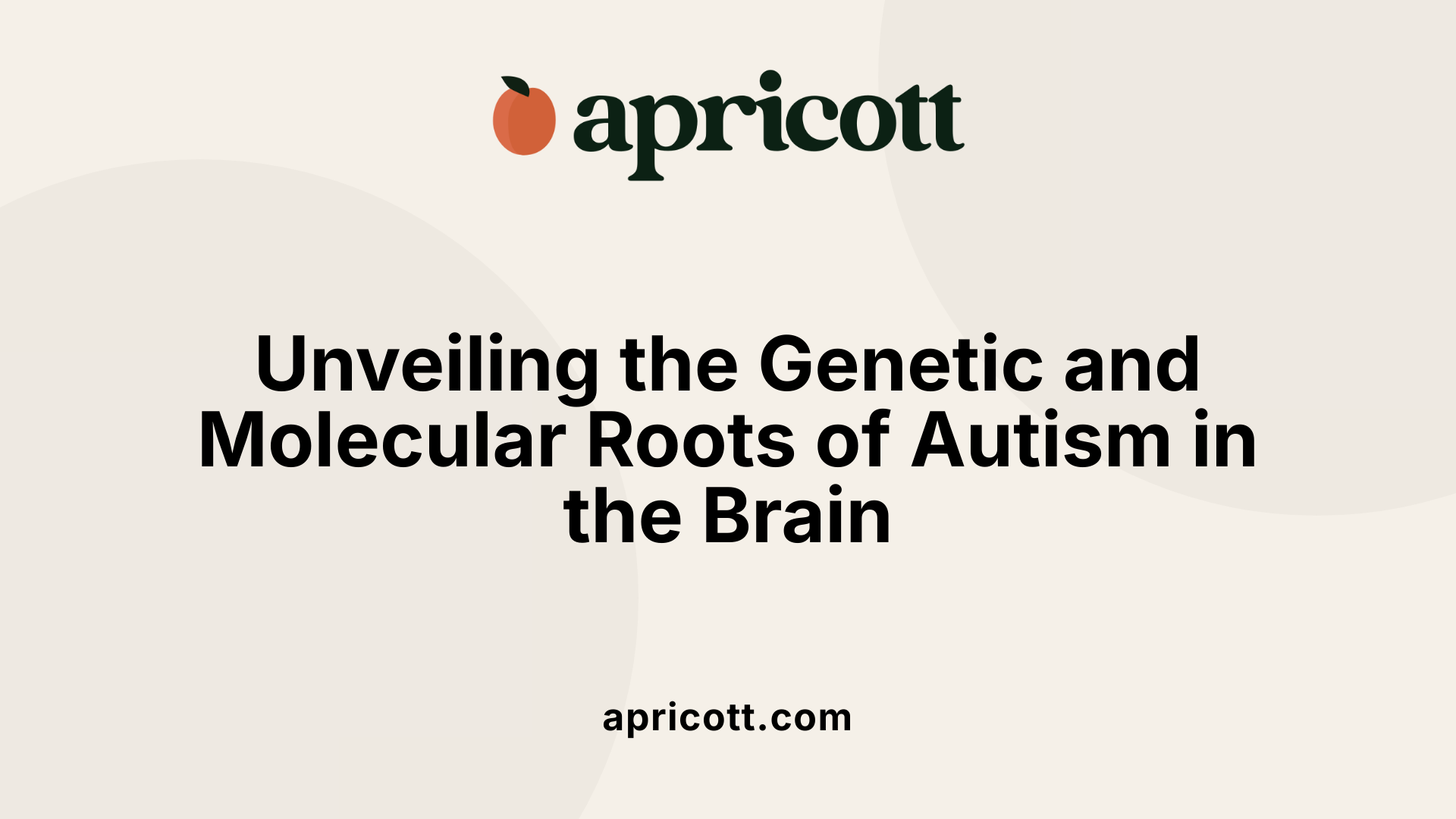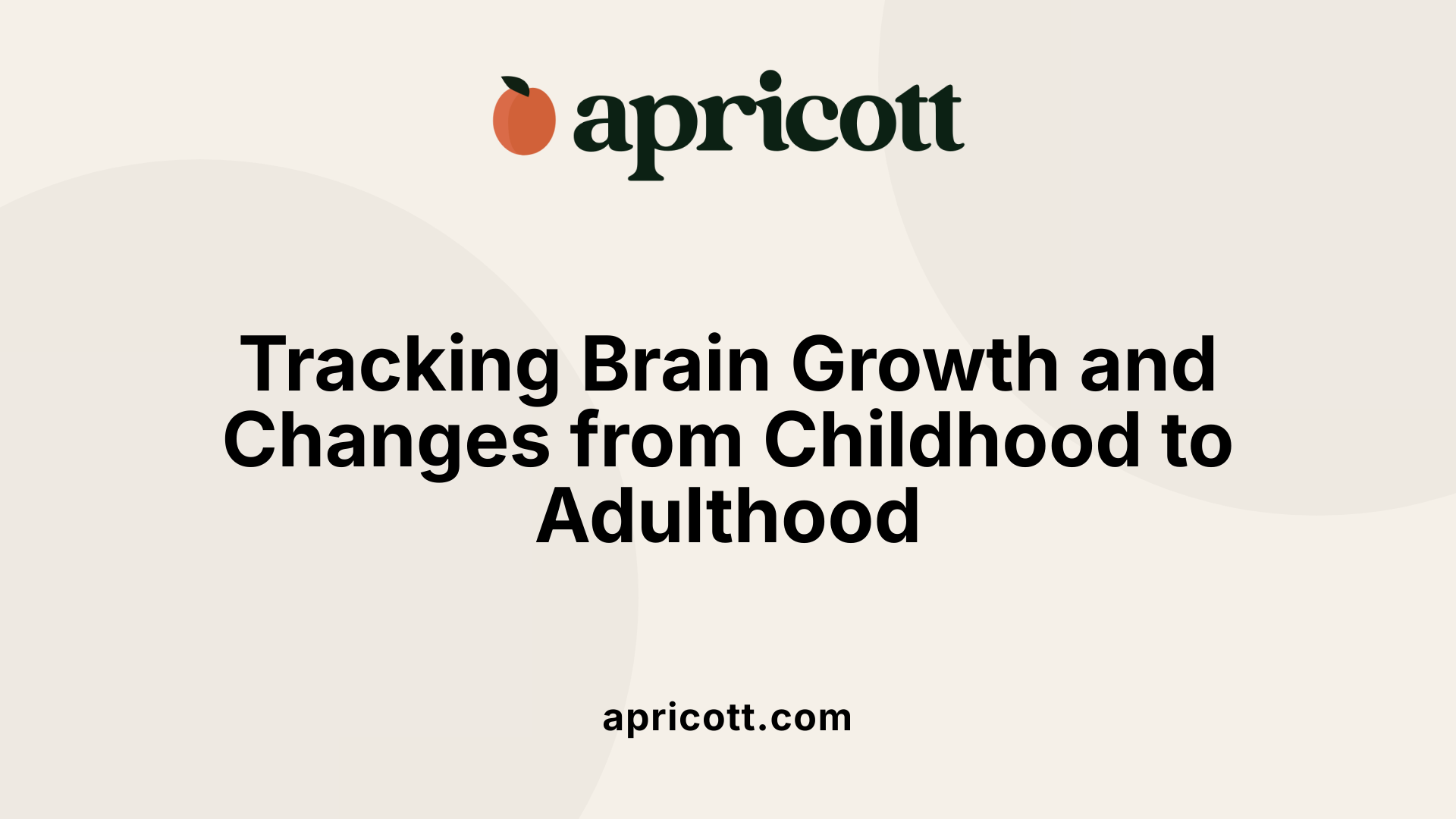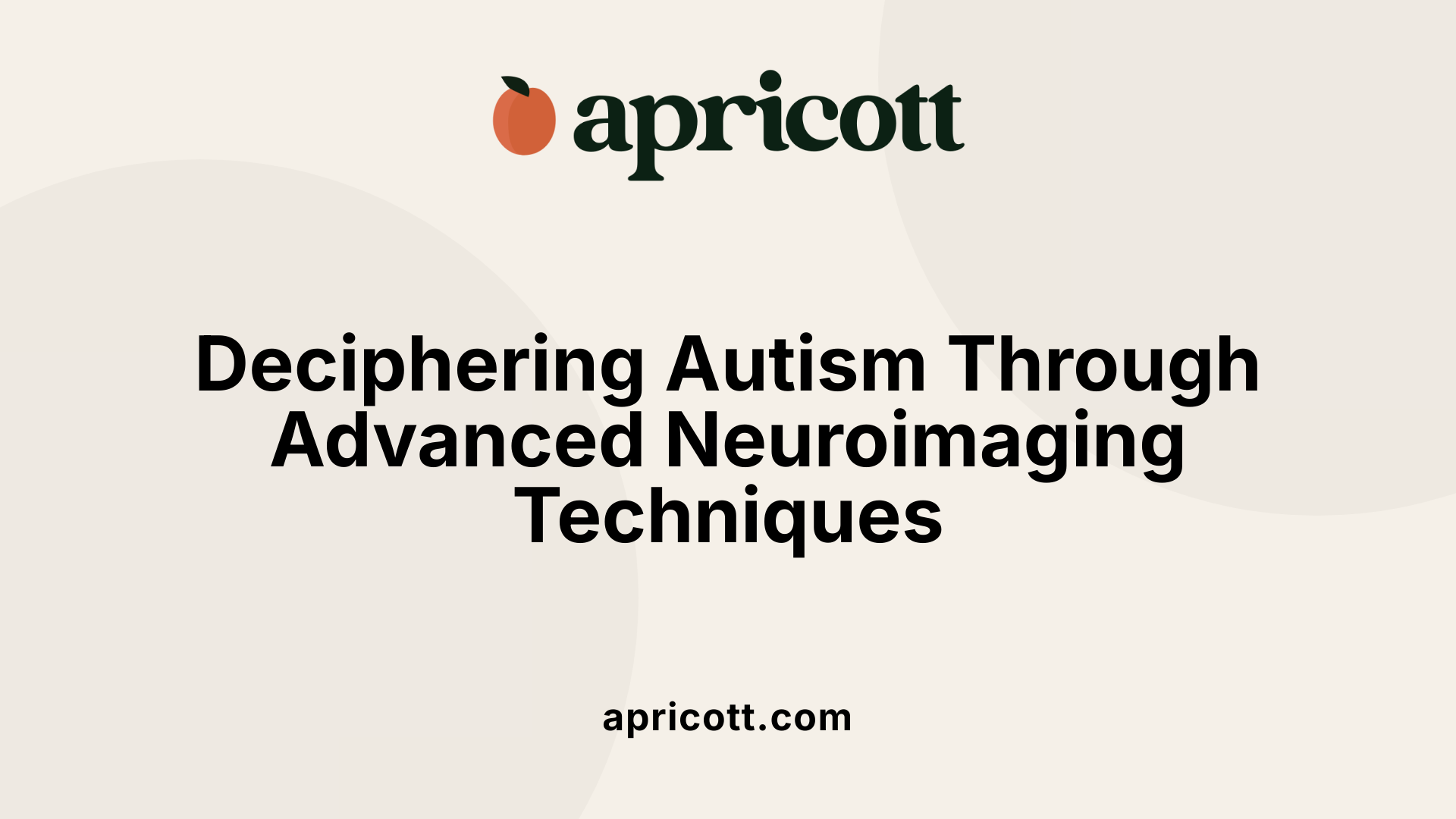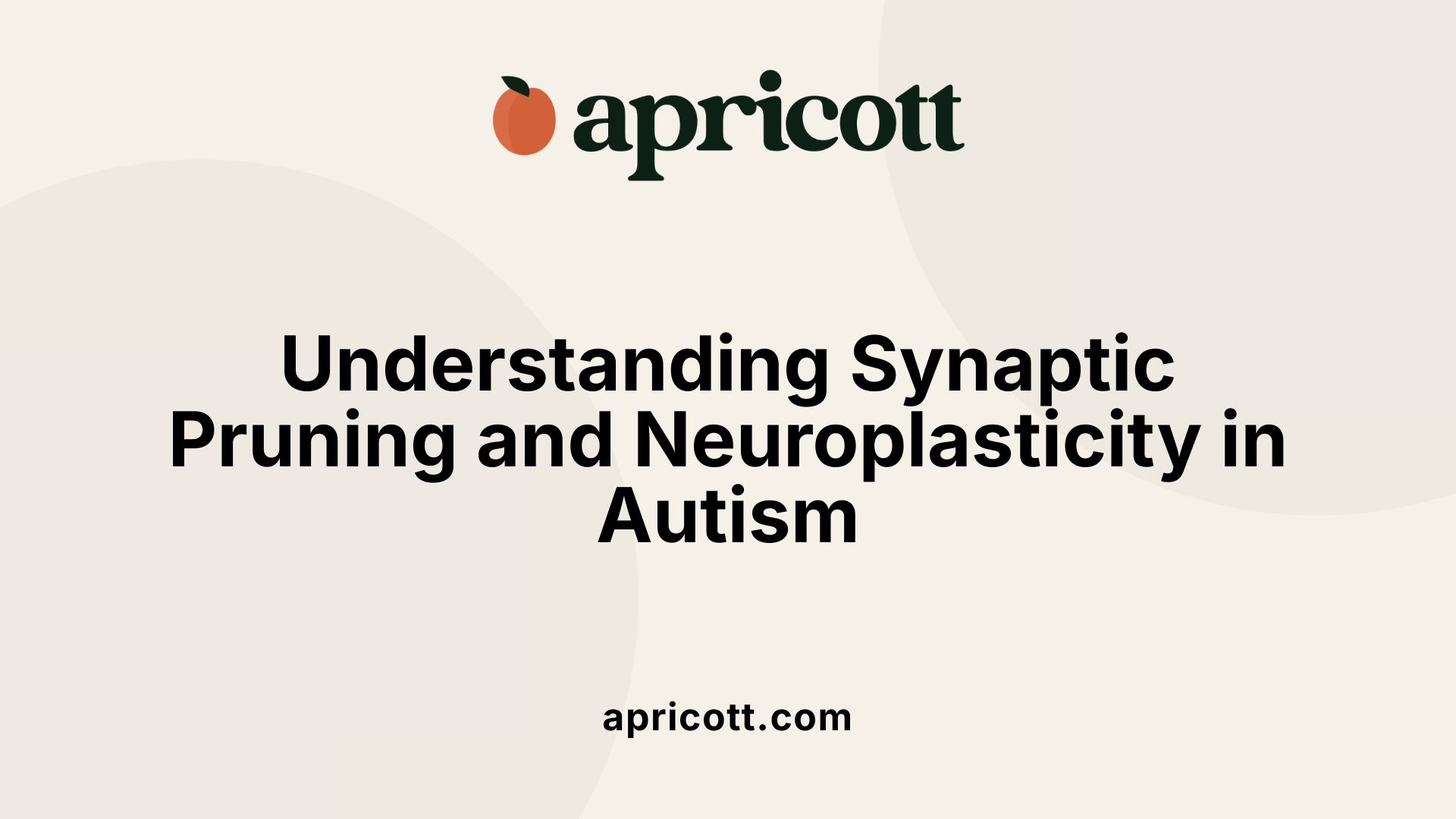August 1, 2025
Deciphering the Neurobiological Landscape of Autism
Autism Spectrum Disorder (ASD) is a complex neurodevelopmental condition characterized by diverse patterns of brain structure, connectivity, and activity. Advances in neuroimaging, genetics, and molecular biology have revealed that autism involves widespread alterations across neural circuits and regions, offering insights into its behavioral manifestations. This article explores recent scientific discoveries about how autism affects the brain, including structural differences, neural connectivity, and molecular mechanisms, shedding light on the neurobiological basis of ASD and paving the way for targeted interventions.

Recent research highlights that autism involves extensive differences across the entire cerebral cortex rather than being confined to specific areas. Studies using RNA sequencing on postmortem brains from individuals with autism (ASD) reveal the largest gene expression changes in the visual and parietal cortices, which relate to sensory sensitivities commonly observed in ASD. Additionally, brain regions such as the amygdala, hippocampus, and various lobes show structural modifications, including variations in cell density, size, and organization.
Neuroimaging investigations further depict altered brain connectivity patterns, with evidence of decreased long-range and increased short-range neural connections. Such changes compromise neural communication, affecting social behaviors, language, and cognition. Notably, differences in sex-specific brain development and immune system gene expression underscore the complexity underlying ASD's neurobiological architecture.
Emerging links between the gut microbiome and neurotransmitter production, such as serotonin, suggest a broader interaction of systemic factors influencing brain function. These substantial discoveries refine our understanding of autism's molecular and structural basis, paving the way for targeted diagnostics and therapies.
People with autism often show atypical brain growth patterns during early life. For instance, rapid brain volume increases occur in the first couple of years, especially in the frontal and temporal lobes, with subsequent growth slowing or arresting later during adolescence and adulthood. This early overgrowth is coupled with increased surface area expansion during the first year, but cortical thickness remains largely unchanged.
Additional structural differences include abnormal gyrification—the folding of the brain's surface—in various regions. During childhood, increased gyrification is often observed in the frontal cortex, later shifting to atypical folding patterns across the lifespan.
Specific regions like the amygdala and cerebellum are also affected. The amygdala may be enlarged in childhood, influencing emotional processing, but later shows size variations depending on age and associated conditions. Microstructural changes, such as decreased cortical thickness or increased cell density, reflect disrupted neurodevelopment. White matter integrity, pivotal for efficient connectivity, shows abnormalities, with some tracts being more or less myelinated, affecting information transmission.
Autism impacts how different parts of the brain communicate. Instead of smooth, efficient networks, individuals with ASD often experience decreased long-distance connectivity necessary for integrating information across regions, coupled with increased local connectivity within specific circuits. This imbalance hampers the brain's ability to coordinate complex tasks involving social cognition, language, and motor control.
Developmentally, this manifests as early brain overgrowth, followed by a reduction in white matter quality and connectivity, particularly affecting neural pathways critical for social interactions. Resting-state fMRI studies emphasize this, showing both decreased synchrony across networks and abnormal activity patterns.
Notably, distinct developmental stages present shifts—from hyperconnectivity in childhood to hypoconnectivity in adulthood—highlighting the dynamic nature of neural network alterations. These connectivity disruptions serve as a foundation for the characteristic challenges in social communication, flexibility, and repetitive behaviors.
Multiple theories explain the neural basis of ASD. A prominent view implicates atypical brain development involving regional volumetric abnormalities like macrocephaly and early overgrowth of the cortex, followed by growth arrest or decline. Structural brain differences include reduced cell size and increased cell density in regions such as the hippocampus, amygdala, and limbic system, which affect emotional and memory processing.
Disruptions in neuronal migration, neurogenesis, and cortical organization contribute to microstructural disarray, supporting models of impaired neural circuit formation. Variations in neural surface features, such as increased or decreased cortical thickness and gyrification, reflect abnormal development.
Genetic influences modify neuroanatomy through mutations affecting synaptic proteins (e.g., SHANK3) and signaling pathways like mTOR, impacting neuron growth, connection, and plasticity.
Key regions impacted include the cerebral cortex, amygdala, hippocampus, cerebellum, and basal ganglia. Structural anomalies like volume changes, cell density adjustments, and connectivity disruptions impinge on circuits regulating emotion, social behavior, and motor functions.
Critical circuits involve the prefrontal cortex for decision-making, the limbic system for emotion, and the cerebellum for coordination and cognitive functions. Connectivity anomalies in the default mode network, salience network, and social brain regions compromise social cognition and language.
Disruptions in glutamatergic, GABAergic, and neuromodulatory systems (oxytocin, serotonin) further impair communication within these circuits, underpinning behavioral core features of ASD.
Neuroimaging reveals that individuals with ASD typically show decreased activation in social brain regions during social tasks, such as the amygdala and superior temporal sulcus. There is also evidence of atypical brain growth trajectories, with exaggerated early growth and subsequent decline.
Functional connectivity patterns are characterized by decreased long-range connectivity, particularly between frontal and posterior regions, and increased local overconnectivity, which can contribute to rigid behaviors and sensory sensitivities.
Resting-state studies report decreased synchrony in networks involved in social-emotional processing and greater variability in neural dynamics. These functional patterns correlate with behavioral severity, including impairments in joint attention, language, and social interaction.
Overall, complex neural activity alterations in ASD reflect disrupted informational flow and network integration, affecting cognitive and social functioning across development.
Genetic research identifies multiple risk genes affecting neuronal development and synaptic function, such as SHANK3, NRXN1, and 16p11.2 copy number variants. These genetic alterations influence pathways like mTOR, Ras, and MAPK, which regulate cell growth, differentiation, and connectivity.
At a molecular level, immune system dysregulation and neuroinflammation are prominent, with increased expression of heat-shock proteins and cytokines within the brain. Changes in neurotransmitter systems, notably GABA and glutamate, disturb excitatory/inhibitory balance, essential for proper neural function.
Gene expression studies show age-dependent patterns, with some genes involved in synaptic plasticity and immune response becoming more dysregulated over time, potentially exacerbating ASD phenotypes.
High-resolution structural MRI assesses cortical and subcortical volumes, surface areas, and folding patterns. DTI evaluates white matter tract integrity, revealing abnormalities in key pathways like the corpus callosum.
Functional MRI (fMRI) measures brain activity and connectivity, providing insights into atypical neural responses during social and cognitive tasks. MRS detects neurochemical alterations such as GABA and glutamate levels.
Emerging technologies like EEG and fNIRS complement MRI techniques by capturing neural activity and network dynamics with excellent temporal resolution, aiding in early detection.
Synaptic overgrowth in children with ASD results from impaired pruning—an essential developmental process that refines neuronal connections. Overactive mTOR signaling hampers autophagy, the cellular cleanup process, leading to excess, often damaged, synapses.
This surplus connectivity disrupts neural circuit balance and information processing, contributing to core ASD features. Microglial dysfunction, immune cells involved in pruning, and neuroinflammation further impair this process, reinforcing the neurobiological foundation of autism.
Structural and functional brain differences underpin the behavioral phenotypes of ASD. Difficulties in social communication, repetitive behaviors, and sensory sensitivities are linked to atypical connectivity, regional size variations, and disrupted neural circuits.
These neural variations influence language development, social understanding, and executive functions, often resulting in diverse developmental trajectories. Recognizing these underlying neural patterns assists in early diagnosis, personalized interventions, and exploring potential treatments targeting specific neural pathways.

Individuals with autism display significant structural variations compared to neurotypical development. In early childhood, there is notable accelerated growth in brain regions such as the frontal and temporal cortices. This rapid expansion typically begins around 6 to 12 months of age, leading to larger brain and head sizes, especially by ages 2 to 4. Key structures such as the amygdala, hippocampus, basal ganglia, and the anterior cingulate cortex often show abnormal size, density, and organization—alterations that can influence emotions, social cognition, and behavior.
Cortical gyrification, which is the folding of the cerebral cortex, also develops atypically in autism. During childhood, increased gyrification has been observed in some areas, while others show reduced folding during adolescence, reflecting disrupted cortical development.
Microstructural features like white matter integrity also vary, with some neural tracts exhibiting increased or decreased myelination and axonal density. These changes are associated with altered neural connectivity that underpins many ASD behaviors.
Neuroimaging studies reveal that these structural differences manifest across the lifespan, impacting networks involved in social processing, language, cognition, and emotional regulation. The cumulative effect of these variations results in the complex behavioral phenotype seen in autism.
Autism is marked by an unusual pattern of early brain overgrowth followed by developmental arrest or decline later in life. Infants with ASD often experience a rapid increase in cortical surface area, starting as early as 6 months. This overgrowth continues through ages 2 to 4, leading to enlarged brain volume. During this phase, children may also show increased size in regions like the cerebellum, hippocampus, and amygdala, which are involved in motor control, memory, and emotion.
After this period, growth tends to slow down or plateau, resulting in stabilization of brain size in many cases. Some individuals experience brain volume just as large or larger than typical adolescents, while others later demonstrate a decline, with reductions in cortex and subcortical structures—sometimes even leading to premature shrinkage before middle age.
This arrested or regressive pattern correlates with behavioral regressions and cognitive changes in some individuals, possibly reflecting disrupted neural pruning and maturation processes. The initial overgrowth and subsequent stabilization or decline are critical periods where early intervention might alter neurodevelopmental trajectories.
As individuals with autism grow older, their brains often follow a trajectory characterized by early overgrowth and subsequent decline. Evidence shows that the brain may begin to shrink or lose volume prematurely, sometimes even before middle age, contrasting with the typical developmental pattern of stabilization into adulthood.
Structural regions such as the hippocampus, cerebellum, and cortex may show reductions in volume over time, which could be linked to neurodegenerative processes or cumulative neural damage. Additionally, persistent abnormal cerebrospinal fluid (CSF) surrounding the brain—observed from early childhood—may influence ongoing cognitive and motor functions.
Emerging research suggests a possible connection between the structural decline and increased risk for neurodegenerative diseases like Alzheimer’s in the aging autistic population. These age-related changes underscore the importance of understanding lifelong brain development in autism and could guide healthcare strategies for aging individuals.
The earliest postnatal years are crucial in shaping the autistic brain. During the first two years of life, rapid brain overgrowth occurs, especially in regions responsible for higher cognitive functions, social behaviors, and emotional processing. This period involves heightened neuronal proliferation, migration, and synaptic formation, which establish the foundational circuitry of the brain.
Atypical cortical development, such as abnormal gyrification, begins during this vulnerable window, affecting how neural networks are configured. White matter maturation, vital for effective communication between brain areas, also shows abnormal patterns that can persist into later years.
After this critical development window, brain growth often arrests. This can lead to altered neural circuitry, insufficient refinement of connections, and disrupted neural plasticity, influencing lifelong functioning.
Recognizing these phases emphasizes the importance of early detection and intervention. Targeting the brain during its most plastic and formative period holds promise for improving outcomes and supporting more typical developmental trajectories in children with ASD.
Understanding these lifespan changes enriches the overall picture of autism’s neurological basis. It highlights the dynamic nature of brain development and its influence on the behavior and capacities observed in autistic individuals at different ages. Further research into these processes will better inform treatment and support strategies tailored to each developmental stage.

Researchers utilize a variety of neuroimaging methods to understand how the autistic brain differs from typical development. Structural magnetic resonance imaging (MRI) helps identify early brain overgrowth, regional volumetric abnormalities, and asymmetries seen in childhood. Diffusion tensor imaging (DTI) assesses white matter integrity, revealing decreased organization and connectivity in roles such as communication between different brain regions. Functional MRI (fMRI) examines patterns of brain activity and connectivity, highlighting atypical activation in social and language areas, as well as abnormal responses to stimuli. Magnetic resonance spectroscopy (MRS) detects biochemical changes like alterations in neurotransmitter levels and other metabolic markers.
Emerging techniques like electroencephalography (EEG) and functional near-infrared spectroscopy (fNIRS) are expanding understanding of functional and neurochemical dynamics. These diverse methods contribute to a comprehensive picture of neural development in ASD, potentially serving as early biomarkers for diagnosis. The integration of neuroimaging data with machine learning algorithms offers promise in improving the accuracy of early detection and understanding individual differences.
Neuroimaging provides vital insights that deepen our understanding of ASD’s complex neural foundations. Structural MRI reveals early brain overgrowth, especially in the frontal and temporal lobes, along with regional anomalies such as increased volume of the amygdala and cerebellum. DTI highlights disruptions in white matter pathways, indicating reduced connectivity between important regions.
Functional imaging techniques like fMRI demonstrate atypical patterns of brain activation. For example, individuals with ASD often exhibit diminished activity in social brain regions like the superior temporal sulcus and the medial prefrontal cortex during social tasks. Resting-state studies show a mixture of hyper- and hypo-connectivity across different networks, with developmental shifts suggesting dynamic changes over time.
Together, these imaging approaches help identify neural circuits involved in core ASD symptoms like social deficits and language challenges. They assist in developing targeted interventions by mapping how atypical neural connectivity underpins behaviors and cognitive functions.
Advanced neuroimaging tools have transformed how researchers investigate ASD. High-resolution MRI allows detailed mapping of early brain overgrowth and regional structural differences. DTI provides insights into white matter development, revealing atypical organization that may hinder neural communication.
Resting-state and task-based fMRI reveal abnormal activity patterns and functional network disruptions. These findings help locate specific circuit abnormalities linked to social, language, and cognitive functions. Magnetic resonance spectroscopy adds a layer by examining neurochemical imbalances, such as altered levels of N-acetylaspartate (NAA) and neurotransmitters.
The combination of multimodal imaging and machine learning enhances the detection of potential biomarkers. These biomarkers improve understanding of individual heterogeneity and aid in developing personalized treatment approaches. Overall, advanced neuroimaging continues to unlock the intricacies of brain development in ASD, guiding early diagnosis and targeted therapies.
| Technique | Focus Area | Key Findings | Specific Contribution |
|---|---|---|---|
| Structural MRI | Brain structure | Overgrowth, asymmetries, regional volume differences | Identifies early developmental anomalies |
| DTI | White matter integrity | Disrupted connectivity | Maps neural pathway organization |
| fMRI | Brain activity & connectivity | Atypical activation, altered networks | Reveals functional abnormalities |
| MRS | Neurochemistry | Neurotransmitter imbalance | Detects biochemical markers |
| Electroencephalography (EEG) | Neural activity | Electrical patterns during tasks | Tracks timing of brain responses |
| fNIRS | Hemodynamic response | Cortical activity during tasks | Monitors oxygenation levels |
This diversity of imaging techniques offers a multi-layered understanding of autism’s neurobiology, progressing toward earlier and more accurate diagnosis, as well as more effective interventions.

Synaptic development involves the formation of connections between neurons, called synapses, which are essential for communication within the brain. During typical development, the brain creates an excess of synapses early on, then gradually prunes unnecessary connections to optimize neural circuitry. In autism, however, this pruning process is often disrupted. Evidence shows that children with ASD tend to retain a surplus of synapses because of reduced or abnormal pruning during critical developmental periods.
This excess of synapses is primarily due to overactive mTOR signaling, a pathway that influences cell growth and autophagy, which is the process of degrading and removing cellular debris, including superfluous synapses. The failure to eliminate excess synapses leads to heightened connectivity, especially in cortical and subcortical regions. This abnormal connectivity can contribute to heightened sensory sensitivity, social challenges, and repetitive behaviors associated with autism.
Further, in the ASD brain, microglia—immune cells responsible for synaptic pruning—may exhibit abnormal activity and inflammatory responses, further impairing the elimination of unnecessary synapses. Altogether, impaired synaptic pruning during early childhood appears to be a core neurobiological feature underlying many of the behavioral and cognitive characteristics of autism.
The central driver of synaptic excess in autism involves the overactivation of the mTOR signaling pathway. mTOR normally regulates protein synthesis, cell growth, and autophagy, the cellular process that clears out excess or damaged components. When mTOR is overactive, autophagy is inhibited, preventing the brain from efficiently pruning surplus synapses.
Animal studies have demonstrated that this overactivity leads to an accumulation of synapses, resulting in increased neural excitability and disrupted neural networks. Microglia, the brain's innate immune cells, also play a significant role. In ASD, microglia are often found to be overactive or chronically inflamed, which can interfere with their normal role of identifying and removing unnecessary synapses.
These molecular and cellular disruptions create abnormal neural circuits characterized by excessive and miswired connectivity. This aberrant wiring affects how the brain processes information, contributing to sensory overloads, difficulties in social interactions, and the core repetitive behaviors seen in autism.
Research into treatments that target synaptic development has gained momentum, particularly focusing on modulating the mTOR pathway. Drugs like rapamycin, an mTOR inhibitor, have shown promising results in preclinical studies. In mouse models of autism, rapamycin successfully restored autophagy and normalized synaptic pruning, leading to significant improvements in behaviors that mirror ASD symptoms.
Additionally, therapies that enhance neuroplasticity—the brain's ability to reorganize itself—are being investigated. Pharmacological agents aimed at balancing excitatory and inhibitory neurotransmission, especially GABAergic and glutamatergic systems, could help correct abnormal connectivity.
Behavioral interventions combined with pharmacological strategies may optimize neural circuit functioning and improve social, communicative, and cognitive outcomes in individuals with autism. Although some treatments are still experimental, they reflect a broader understanding that targeting synaptic regulation and neuroplasticity pathways could be vital in treating ASD.
Emerging evidence continues to support the idea that correcting the underlying synaptic imbalances may not only alleviate symptoms but also alter developmental trajectories if implemented early. As research advances, developing safe and effective therapies focused on synaptic health remains a promising frontier in autism treatment.
Recent advances in understanding how autism affects the brain at structural, functional, and molecular levels have highlighted the disorder’s complexity and diversity. Aberrant growth patterns, connectivity disruptions, synaptic abnormalities, and genetic influences shape the neurobiological landscape of ASD. Recognizing these intricate neural differences offers pathways for early diagnosis and personalized therapies, fostering strategies that target specific neural circuits and molecular pathways. Continued research integrating neuroimaging, genomics, and neurobiology is essential to develop more effective interventions, ultimately improving outcomes and quality of life for individuals across the autism spectrum.